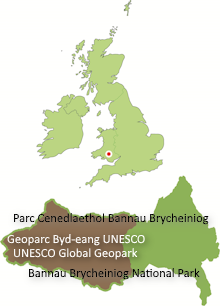People have been shaping and reshaping this landscape for thousands of years. The Timeline should help you understand what happened when during the last few centuries.
Key events which have shaped this area are listed in chronological order. Some took place outside the Geopark area but had profound effects within it, for example the building of canal links to the south which permitted increased mining and quarrying activity in the hills of the Geopark.
If you want to look further back in geological time then take a look at the geological timescale.
Year
- AD 50s & 60s: Roman campaigns probe west to the Tywi valley, establishing camps in Mynydd Myddfai area. Roman fort of Brecon Gaer established.
- c.200: Brecon Gaer ceases to function as a Roman military base
- 1093: Having defeated the Welsh rulers of the region, Bernard de Neufmarche, first Norman Lord of Brecon created the hunting preserve of ‘the Great Forest of Brecknock’.
- c. 1095: Bernard de Neufmarche constructs motte at Trecastle.
- 1096: Battle of Aber-llech – Welsh victory over Norman forces at confluence of Nant Llech and Afon Tawe near Abercraf
- c.1100: Brecon Cathedral begins life as a Benedictine priory.
- 1248: Welsh Lord, Rhys Fychan regains control of Carreg Cennen Castle from English.
- 1277: King Edward I seizes Carreg Cennen Castle from Maredudd ap Rhys Grug.
- 1403: English stronghold of Carreg Cennen Castle besieged during rebellion led by Owain Glyndwr.
- 1462: Destruction of Carreg Cennen Castle after its Lancastrian occupiers were defeated by the Yorkists in the Wars of the Roses.
- 1521: The Crown acquires the lands of the ‘Great Forest of Brecknock’.
- c.1550: The ‘Little Ice Age’ begins
- 1617: Agistment of the Great Forest granted to Sir Francis Bacon and others.
- 1695: Death of Henry Vaughan
- 1724: Daniel Defoe visits the area and writes of it as ‘horrid and frightful’
- 1755: Brecknockshire Agricultural Society founded
- 1760: The start of the Industrial Revolution.
- 1780s: Silica rock first quarried near Craig-y-ddinas
- 1794: Construction of Swansea Canal starts.
- 1795: Completion of the Neath Canal from Neath to Glyn-neath.
- 1798: Construction of Swansea Canal to Abercraf completed.
- 1807: ‘Dr Bevan’s tramroad’ constructed from Dinas Rock to the Neath Canal.
- 1808: Act of Parliament enables the sale of the Great Forest of Brecknock.
- 1816: Brecon & Hay Tram Road opened.
- 1817: Great Forest enclosed.
- 1819: (or 1815?) Wealthy London merchant John Christie purchased a large part of the Great Forest as it is sold by the Crown to finance the Napoleonic Wars.
- 1819: Amman Valley mine owner, John Jones constructs the modern Brynaman-Llangadog road over the Black Mountain.
- 1820: William Weston Young invents the refractory brick (or ‘firebrick’)
- 1821: John Christie completes construction of model farm at Cnewr.
- 1822: William Weston Young founds the Dinas Silica Brick Company.
- 1824: John Christie completes the 10 mile long tramroad from Pwll Byfre quarry to Sennybridge.
- 1825: John Christie constructs limekilns at Twyn-y-ffald, Penwyllt.
- 1826: John Christie begins construction of various tramways on Cribarth.
- 1827: John Christie declared bankrupt.
- 1835, December: Gloucester & Carmarthen Mail Coach crashes into ravine outside Llandovery. A monument is subsequently erected beside the road warning of the dangers of drink-driving.
- 1836: New hot blast iron-smelting technique developed by David Thomas at the ironworks owned by George Crane at Ynyscedwyn near Ystradgynlais.
- 1839: Sir Roderick Murchison publishes ‘The Silurian System’ following fieldwork in central Wales.
- 1840: New limekilns at Twyn Disgwylfa replace those at Twyn-y-ffald, Penwyllt.
- 1840: Brecon Forest Tramroad Company was forcibly wound up.
- 1840s: Craig-y-nos Castle constructed.
- 1841, April: Llygad Llwchwr cave first explored by Thomas Jenkins of Llandeilo.
- 1842: Shire Hall, Brecon built – became Brecknock Museum & Art Gallery in 1974
- 1845: Banwen Ironworks founded
- 1846, June: Training to be a field naturalist, Alfred Russel Wallace walks from Neath to Pen y Fan and back via Sgwd Gwladus and Cwm Porth – he later spurs Charles Darwin to publish ‘On the Origin of Species’.
- c.1850: The ‘Little Ice Age’ ends
- 1851: Opening of the Vale of Neath Railway. It was to take trade away from the Neath Canal which finally closed as a result.
- 1854, October: George Borrow records his trip across the Black Mountain in ‘Wild Wales’.
- 1857: Establishment of the Vale of Neath Powder Company’s works at Pontneddfechan.
- 1859: The Brecon & Merthyr Railway opens.
- 1862: Curtis & Harvey take over operation of the Gunpowder Works.
- 1863: Pentwyn Reservoir completed by Merthyr Health Board.
- 1869: Completion of the Neath & Brecon Railway between the two towns.
- 1878: Opera singer, Adelina Patti purchases Craig-y-nos Castle.
- 1884: Henllys Vale Colliery established?
- 1884: Lower Neuadd Reservoir completed by Merthyr Tydfil Corporation.
- 1892: Cantref Reservoir completed by Cardiff Corporation.
- 1897: Beacons Reservoir completed by Cardiff Corporation.
- 1898: Henllys Vale Colliery opened?
- 1900, August: Tommy Jones disappears at the head of Cwm Llwch. He is later commemorated by a granite obelisk.
- 1902: Upper Neuadd Reservoir completed by Merthyr Tydfil Corporation.
- 1904, May: Tragic death of youth, David John Morgan on Black Mountain, later commemmorated in verse: ‘From the Mist to Heaven’
- 1906, 27 June: The Swansea Earthquake felt all around the region.
- 1907: Cray Reservoir opened.
- 1912: Jeff and Ashwell Morgan first explore Dan-yr-Ogof cave.
- 1914: Ystradfellte Reservoir completed by Neath Rural District Council
- 1919: End of the First World War and setting up of the Forestry Commission with a remit to supply Britain’s strategic timber needs.
- 1920: Penderyn Reservoir completed by Mountain Ash UDC.
- 1921, March: Craig-y-nos Castle and grounds sold to the Welsh National Memorial Trust for £11,000 and was established as the ‘Adelina Patti Hospital’ for tuberculosis sufferers.
- 1926: Nobel’s Explosive Company at Pontneddfechan becomes part of Imperial Chemical Industries.
- 1926: Llwyn-onn Reservoir completed by Cardiff Corporation.
- 1926: General Strike includes strike by colliers: some marginal land brought back into production.
- 1927: Pontsticill Reservoir completed by Merthyr Tydfil Corporation.
- 1930s: Level of Llyn y Fan Fach raised to supply water to Swansea.
- 1931, 31 December: Final closure of the Gunpowder Works at Pontneddfechan
- 1932: Demolition and burning of Gunpowder Works at Pontneddfechan
- 1932: Carreg Cennen Castle is placed in the guardianship of the Government Office of Works.
- 1934: Final closure of the Neath Canal – though it had seen little traffic for years.
- 1941: Iron-making ceases at Ynyscedwyn, Ystradgynlais
- 1946: Peter Harvey and Ian Nixon discover Ogof Ffynnon Ddu, Britain’s deepest cave, in the upper Swansea Valley. The known section is 308m/1010ft deep.
- 1949: The National Parks & Access to the Countryside Act is passed, paving the way for the designation 8 years later of the Brecon Beacons National Park.
- 1950s: Silica sand quarries at Pal y Cwrt close down.
- 1955: Usk Reservoir opened by HM Queen Elizabeth II
- 1957: Brecon Beacons National Park is designated
- 1960: The Brecon & Merthyr Railway closes.
- 1962: The Neath & Brecon Railway closes to passengers.
- 1974: Local government reorganisation in Wales sees (amongst others) the counties of Dyfed, Powys and West Glamorgan created.
- 1977: Final closure of the Neath & Brecon Railway to all traffic.
- 1980, June: Brecon Mountain Railway opens on a section of the line of the former Brecon & Merthyr Railway.
- 1984: Purchase by National Park Authority of 9300Ha of common land including much of the Black Mountain, Fforest Fawr, Cefn Llechid and Mynydd Illtud.
- 1984-85: National miners’ strike – major event in history of South Wales Coalfield, affecting communities along southern fringe of Geopark
- 1985, 31 March: Closure of the tuberculosis hospital at Craig-y-nos Castle.
- 1987, March: National Park Authority purchases Garn Goch
- 1993, June: National Park Authority purchases the Arcway (old railway line) between Hirwaun and Penderyn and subsequently develops it as a trail.
- 1996, April: Establishment of new unitary authorities across Wales to replace the two-tier structure which had been in place since 1974. These included Powys County Council, Carmarthenshire County Council, Merthyr Tydfil County Borough Council and Rhondda Cynon Taf County Borough Council.
- 2001: Foot & Mouth disease breaks out in Essex and later spreads to Wales, effectively closing large swathes of the National Park.
- 2001, November: The Countryside & Rights of Way Act is passed by Parliament paving the way for open access in Wales 3 ½ years later.
- 2005, 28 May: The public’s right to open access on foot across registered common land, mountain, moor, heath & down commences in Wales.
- 2005, October: Fforest Fawr becomes a member of the European Geoparks Network and UNESCO-assisted Global Network of National Geoparks.
- 2008, September: Fforest Fawr Geopark is successfully revalidated.
- 2012, September: Fforest Fawr Geopark is successfully revalidated for a second time.
- 2015, November: Fforest Fawr becomes a member of the new UNESCO Global Geoparks Network.
- 2016, July: Fforest Fawr hosts revalidation visits for third time (but first time as a UNESCO Global Geopark).
- 2017, January: Fforest Fawr UNESCO Global Geopark hears from UNESCO that third revalidation has been successful (so-called ‘green card’).



